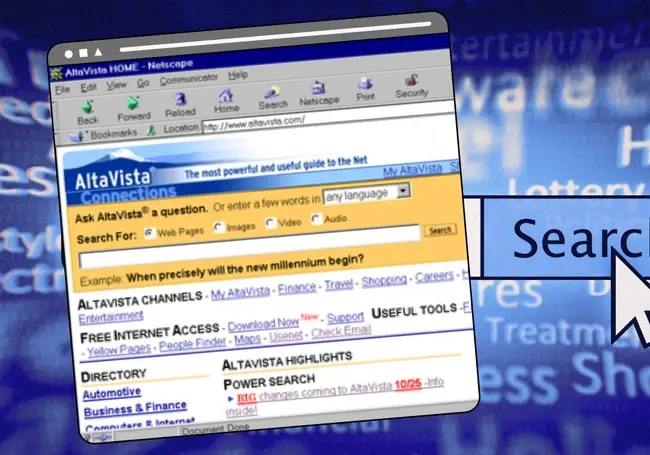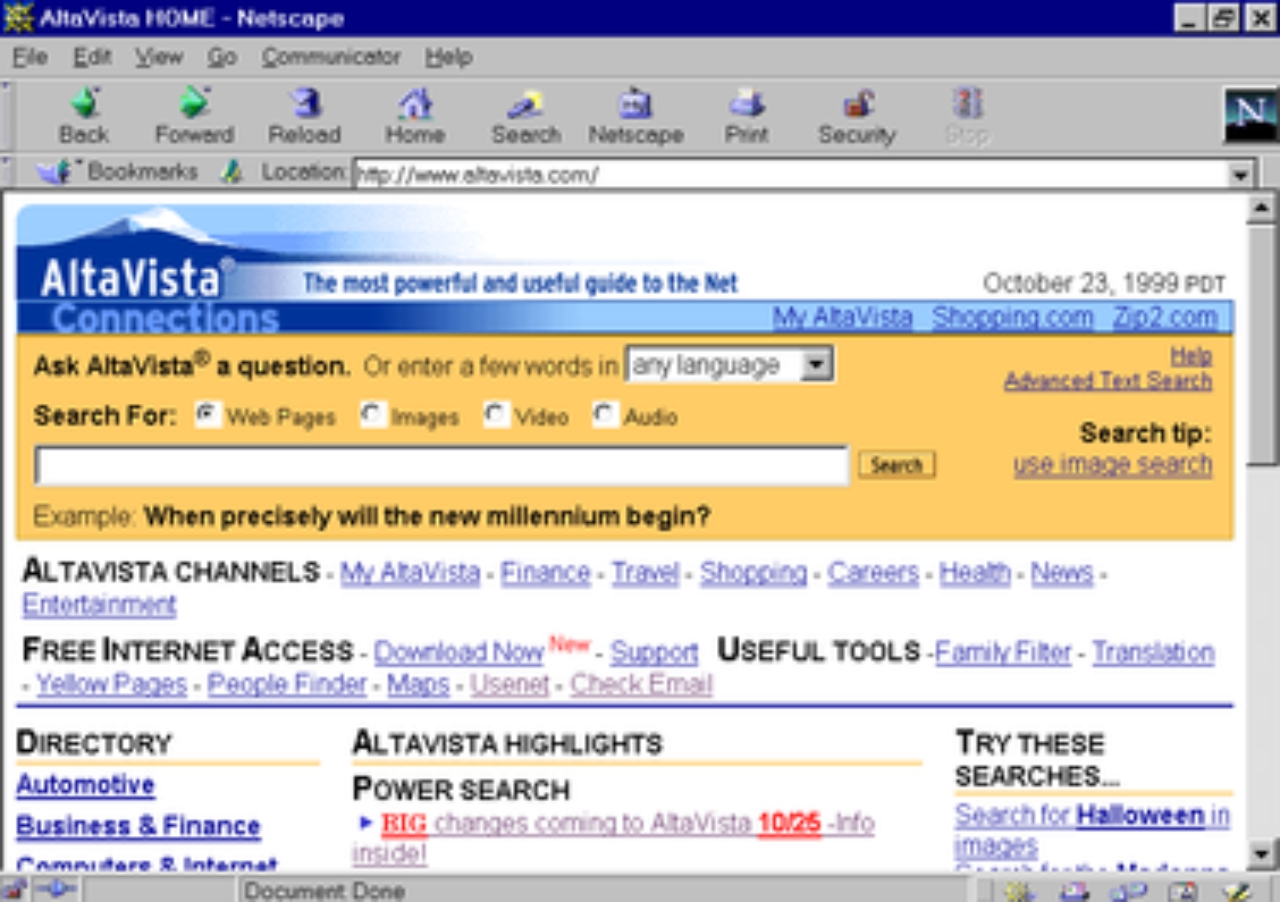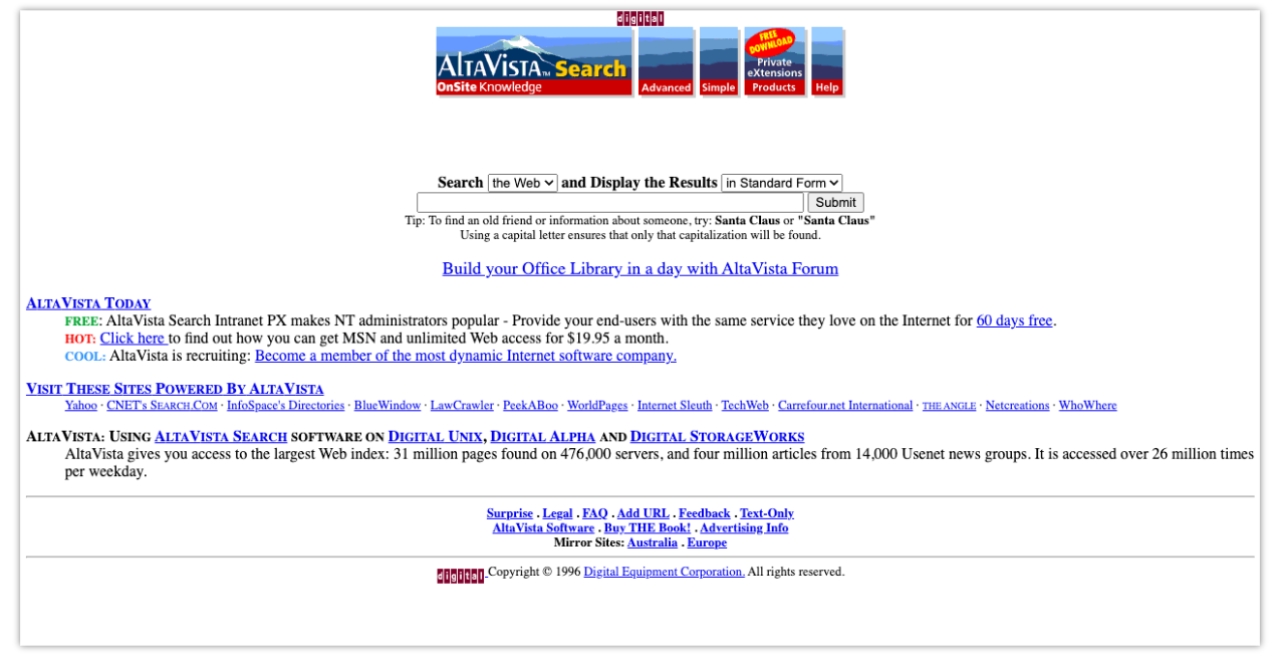In 1995, one of the first major search engines came into existence in the form of an experiment born out of the research labs of Digital Equipment Corporation.
This experiment, called AltaVista, would prove more successful than its team of developers, led by Paul Flaherty, could have ever imagined. It would provide the early adopters of the internet with a one-of-a-kind platform for searching for information in a way that other search engines at the time couldn’t.
It would create what would later become known as the first ever modern search engine, inspiring a period of online search that remains largely unchanged over two decades on.
But ask anyone what AltaVista is today, and they’d probably have to Google it. Over a quarter of a decade after its launch, the platform is nothing more than a reminisce of a bygone era of the internet and online search.
This article delves deep into what happened to AltaVista, exploring the rise and fall of the first major search engine and why it failed to take off.

What is AltaVista?
AltaVista was a groundbreaking search engine created by Digital Equipment Corporation (DEC) in 1995. It was one of the earliest and most popular keyword-based search tools on the World Wide Web in the mid-90s and is widely considered to be the first major search engine in history.
AltaVista was the first searchable, full-text database on the World Wide Web with a simple interface It was also the first search engine to index a vast amount of content from across the World Wide Web, making it by far the most effective search tool of its time.

The AltaVista homepage in 2001.
It used 20 multi-processor machines using DEC's 64-bit Alpha processor. Together, the back-end machines had 130 GB of RAM and 500 GB of hard disk drive space and received 13 million queries every day.
AltaVista rapidly gained popularity due to its speed, accuracy, and ability to index a vast amount of web content. At its peak, it handled millions of search queries daily.
The Birth of AltaVista
AltaVista was born out of the research labs of Digital Equipment Corporation (DEC) in the mid-1990s. The concept originated from the need to harness the power of DEC's supercomputers to create a tool that could efficiently index and search the internet.
A team of researchers, led by Paul Flaherty, sought to create a tool that could efficiently index and search the growing web. They called it AltaVista the Spanish phrase meaning "high view" to demonstrate their ambition to provide a comprehensive overview of the internet.
The combined storage of AltaVista's two main computers, Scooter and Turbo Vista, was a modest 270 gigabytes. This might seem tiny by today's standards, but it was impressive at the time. Scooter, with its 20-gigabyte hard drive, collected web pages, while Turbo Vista, boasting a 250-gigabyte drive and double the RAM, stored and served up the information.

AltaVista web portal in 1999.
AltaVista also had a one-of-a-kind minimalistic interface, similar to the modern search engine, which was lost when it became a Web portal, but regained when it refocused its efforts on its search function. This interface allowed the user to limit search results from a domain, reducing the likelihood of multiple results from the same source.
Originally, AltaVista was a simply a showcase project for Digital Equipment Corporation's (DEC) powerful Alpha processor. Paul Flaherty, tasked with demonstrating the Alpha's capabilities, conceived the idea while on vacation. DEC employees Michael Burrows and Louis Monier later developed the search engine.
AltaVista's rise
What set AltaVista apart when it launched in 1995 was its ability to index and search the vast pages of the World Wide Web. While earlier search tools were rudimentary, AltaVista offered full-text searching, allowing users to find specific words or phrases within web pages.
Before AltaVista, the internet was seen as a collection of random pages, and AltaVista turned it into a place where people could easily find the information they needed. Leveraging the Alpha processor's speed and capacity, Flaherty and his team developed a search engine that could index vast amounts of web data and deliver search results with unprecedented speed.
The Alpha processor, combined with efficient algorithms, enabled AltaVista to process search queries rapidly and handle a growing volume of users. This would mark the start of a new era of search, where finding information online became quick and easy.
This meant that when AltaVista launched in 1995, it spread like wildfire. Traffic increased steadily from 300,000 hits on the first day to more than 80 million hits per day two years later. The ability to search the Web, and AltaVista's service in particular, was e one of the top destinations on the Web, and it became the 11th most visited Web site in 1998 and in 2000.
AltaVista was the also most favoured search engine used by professional researchers in the "Internet Search-Off" study in February 1998, with 45% of the researchers choosing it. The second place belonged to HotBot at 20%.
The Decline and Fall of AltaVista
In 1998, Digital was sold to Compaq, and in 1999, Compaq redesigned AltaVista as a Web portal in a last-ditched effort to compete with Yahoo.
Under CEO Rod Schrock, it abandoned its streamlined search page and transformed itself into a web portal, diluting its core search function with features like shopping and email.
This backfired drastically. By focusing on becoming a full-fledged web portal, AltaVista diluted its core strength: search.
The company's resources were diverted away from refining its search algorithms and improving search results, and this allowed competitors like Google and Yahoo, which remained laser-focused on search, to gain a decisive advantage.
Read more: Why did Yahoo Fail? The Rise and Fall of a Dot-Com Tech Giant
Struggling to make AltaVista profitable amidst increasing pressure from Yahoo, in 1999 Compaq sold an 83% stake to CMGI, owner of the Lycos search engine. CMGI brought forward plans for an IPO that were ultimately scrapped due to the dot-com bubble burst. By this point, Google's rise was undeniable, and AltaVista was losing ground rapidly.
Despite attempts to refocus on the search and improve its results, AltaVista was acquired by Overture Services in 2003, which itself was bought by Yahoo shortly after. This led to AltaVista being integrated into the Yahoo search platform to power the same search engine it once supplied results for.
Does AltaVista still exist today?
In a Tumblr post on June 28, 2013, Yahoo announced on its Tumblr page that it would be shutting down Altavista on July 8 2013 after a decade of the search engine being integrated into Yahoo search. Since then, the domain has been redirected to Yahoo’s search and no longer exists as a standalone site.
“Earlier this year, we announced an ongoing effort to sharpen our focus and deliver experiences that enhance your daily lives,” Yahoo’s Tumblr post read announcing the end of AltaVista.
“As part of that, today we’re shutting down a few products so we can continue to focus on creating beautiful products that are essential to you every day,” the post read.
Despite being the most popular search engine as recently as 2000, a series of poor decisions – particularly the misguided and eventually reversed choice to turn the search engine into a Yahoo-style search portal – ultimately led to AltaVista losing its place as a top search engine.
Today, AltaVista has become a reminisce of a bygone era of search, disconnected from its domain name and ultimately forgotten about by most regular internet users.

The archived simple search interface from 1996.
Users can still access an achieved version of the AltaVista homepage, but the search engine does not function beyond that.








Comments ( 0 )